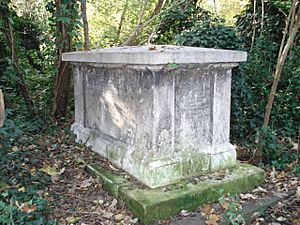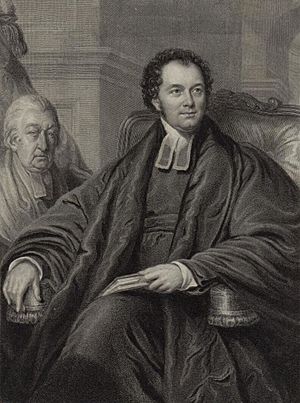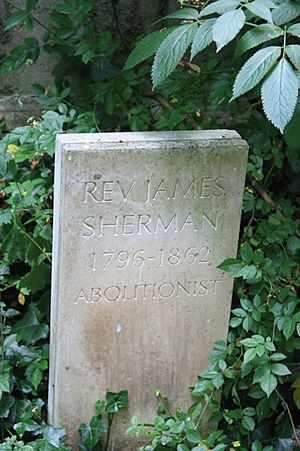James Sherman (minister) facts for kids
James Sherman (born February 21, 1796 – died February 15, 1862) was an English Congregationalist minister. This means he was a leader in a type of Christian church where each local church makes its own decisions.
Sherman was a strong supporter of ending slavery. He was a very popular speaker at The Castle Street Chapel in Reading from 1821 to 1836. Later, he and his second wife, Martha Sherman, helped make Surrey Chapel in Blackfriars, London, very successful from 1836 to 1854. Martha passed away in 1848.
James Sherman took over from Rowland Hill at the Surrey Chapel. Even though he became known as a Congregationalist, he was first trained in a different church group called the Countess of Huntingdon's Connexion.
Contents
Early Life and Ministry
James Sherman was born in London on February 21, 1796. His father was an officer in the East India Company. James learned from different religious teachers. For three and a half years, he worked as an apprentice to someone who carved ivory.
In 1815, Sherman started studying at the Countess of Huntingdon's Cheshunt College. He gave his first sermon in London in 1817. In 1818, he officially became a minister in Sion Chapel, Whitechapel.
After preaching in Bath, he became the main minister at the Countess of Huntingdon's chapel in Bristol. There, he met famous writers Hannah More and Mary Anne Schimmelpenninck. In April 1821, he moved to the Castle Street chapel in Reading, Berkshire.
Supporting Missionary Work
James Sherman was a big supporter of missionary work. This is when people travel to other places to share their religious beliefs. He mainly supported the London Missionary Society. This group was open to different Christian churches.
For example, in 1836, the Rev. Samuel Oughton was sent to Jamaica from Sherman's Surrey Chapel. This was done with the Baptist Missionary Society, which worked closely with Sherman's group.
Helping Start Abney Park Cemetery
Around 1840, James Sherman became a founder and leader of a new project. This was Abney Park Cemetery, a burial ground for Congregationalists.
This cemetery was special because it was open to everyone. People from any church or background could be buried there. There were no dividing lines between different religious groups. It was the first garden cemetery in Europe to be completely open to all. It also had only one chapel for everyone to share.
Writing Books
James Sherman first wrote books about religious devotion. But in the 1840s, he started writing biographies. Biographies are books about someone's life.
In 1848, James Sherman wrote The Pastor's Wife. This book was about his wife, Martha, after she passed away from an illness that year. He also wrote biographies of Rowland Hill and William Allen. William Allen was a Quaker who also worked to end slavery.
Working to End Slavery
One of James Sherman's most important contributions was his work against slavery. In the 1850s, he helped with a very famous book called Uncle Tom's Cabin. This book was written by an American author named Harriet Beecher Stowe.
Sherman wrote the introduction for the London edition of Uncle Tom's Cabin. The book was first published in parts in an anti-slavery newspaper in 1851. When it came out as a full book in 1852, with Sherman's introduction, it became a historic work. It sold more copies than almost any other American book at the time.
When Harriet Beecher Stowe visited London in 1852, she and her family stayed at Sherman's house. At the same time, he invited Samuel Ringgold Ward to stay with him. Ward was an African-American man who had escaped slavery and become a minister. Sherman helped Ward stay in Britain for almost a year. He also helped Ward raise money for the Canadian Anti-slavery Society. This group helped enslaved people from the USA find freedom in British Canada.
Later Life and Legacy
From 1854 to 1862, Sherman was a minister at Blackheath Congregational Church. Christopher Newman Hall took over from Sherman at Surrey Chapel. Hall continued Sherman's work against slavery. He visited America during the Civil War and wrote books and gave speeches to get British support for the North. He believed that Britain should support the North because freeing enslaved people was the right thing to do.
Death and Memorial

James Sherman passed away at his home in Blackheath. He was buried in a simple stone tomb at Abney Park Cemetery in Stoke Newington, London. This was the same non-denominational garden cemetery that he helped to found. His memorial stone can be seen among the plants from the path. A newer marker stone has been placed in front of the original one. This helps people find his grave more easily.
Books by James Sherman
- Sherman, James (1851) Memoir of William Allen, London: Charles Gilpin
- Sherman, James (1850 edn.) The Pastor's Wife: a memoir of Mrs Martha Sherman, New York: American Tract Society




